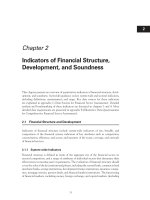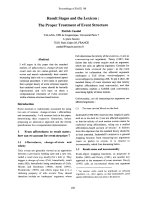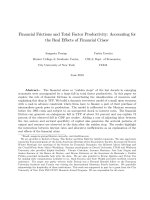Analysis of financial structure pot
Bạn đang xem bản rút gọn của tài liệu. Xem và tải ngay bản đầy đủ của tài liệu tại đây (487.72 KB, 22 trang )
Chapter 8
An Economic
Analysis of
Financial Structure
Copyright © 2007 Pearson Addison-Wesley. All rights reserved.
8-2
Copyright © 2007 Pearson Addison-Wesley. All rights reserved.
8-3
Eight Basic Facts
1. Stocks are not the most important sources of
external financing for businesses (figure 1)
==> Why?
2. Issuing marketable debt and equity securities
is not the primary way in which businesses
finance their operations (figure 1) ==> Why?
3. Indirect finance is many times more important
than direct finance ((figure 1) ==> Why?
4. Financial intermediaries are the most
important source of external funds (figure 1)
==> Why?
Copyright © 2007 Pearson Addison-Wesley. All rights reserved.
8-4
Eight Basic Facts (cont’d)
5. The financial system is among the most
heavily regulated sectors of the economy
6. Only large, well-established corporations
have easy to issue securities to markets to
finance their activities
7. Collateral is a prevalent feature of
debt contracts
8. Debt contracts are extremely complicated
legal documents that place substantial
restrictive covenants on borrowers
Copyright © 2007 Pearson Addison-Wesley. All rights reserved.
8-5
Transaction Costs
•
Financial intermediaries have evolved to reduce
transaction costs [ex: mutual funds]
Economies of scale
Expertise
Copyright © 2007 Pearson Addison-Wesley. All rights reserved.
8-6
Asymmetric Information
•
Adverse selection occurs before
the transaction
•
Moral hazard arises after the transaction
•
Agency theory analyses how
asymmetric information problems affect economic
behavior
Copyright © 2007 Pearson Addison-Wesley. All rights reserved.
8-7
Adverse Selection:
The Lemons Problem
•
If quality cannot be assessed, the buyer is
willing to pay at most a price that reflects the
average quality
•
Sellers of good quality items will not want to
sell at the price for average quality
•
The buyer will decide not to buy at all because
all that is left in the market is poor quality items
•
This problem explains fact 2 and partially
explains fact 1
Copyright © 2007 Pearson Addison-Wesley. All rights reserved.
8-8
Adverse Selection: Solutions
•
Private production and sale of information
Free-rider problem
•
Government regulation to increase information
Fact 5
•
Financial intermediation
Facts 3, 4, & 6
•
Collateral and net worth (Equity)
Equity = Asset – Liability
Fact 7
Copyright © 2007 Pearson Addison-Wesley. All rights reserved.
8-9
Moral Hazard in Equity Contracts
•
Called the Principal-Agent Problem
-
Agent: the managers of the firm (own only
small fraction of equity of the firm)
-
Principal: owner of the firm (own large fraction
of equity of the firm)
•
Separation of ownership and control
of the firm
Managers pursue personal benefits and power
rather than the profitability of the firm
Copyright © 2007 Pearson Addison-Wesley. All rights reserved.
8-10
Principal-Agent Problem: Solutions
•
Monitoring (Costly State Verification) =>
auditor => costy
Free-rider problem (not buy information any more)
•
Government regulation to increase information
Fact 5
•
Financial Intermediation (venture capital firm)
Fact 3
•
Debt contract (instead of buy stock, take a
debt contract)
Copyright © 2007 Pearson Addison-Wesley. All rights reserved.
8-11
Moral Hazard in Debt Markets
•
Borrowers have incentives to take on projects that are
riskier than the lenders would like
Copyright © 2007 Pearson Addison-Wesley. All rights reserved.
8-12
Moral Hazard: Solutions
•
Net worth and collateral
“Incentive compatible”: The greater the borrower equity, the
greater the borrower’s incentive to behave in the way that the
lender expects & desires ( and vice versa)
•
Monitoring and Enforcement of Restrictive Covenants
Discourage undesirable behavior => sử dụng vốn vay đúng
Encourage desirable behavior => mục đích đi vay
Keep collateral valuable
Provide information (provide financial statement periodically)
=> However, these solution just reduce moral hazard problem, not
eliminate it (p.197)
=> Solution: Financial Intermediation (no free-rider)
Facts 3 & 4
Copyright © 2007 Pearson Addison-Wesley. All rights reserved.
8-13
Copyright © 2007 Pearson Addison-Wesley. All rights reserved.
8-14
Problem in developing contries
1/ Disclosure of information: poor => law
2/ Gov. use financial systems to direct credit to themselves
or to favored sectors of the economic
3/ Auditing and Consulting in Accounting Firms
Auditors may be willing to skew their judgments and
opinions to win consulting business
Auditors may be auditing information systems or tax
and financial plans put in place by their nonaudit
counterparts
Auditors may provide an overly favorable audit to
solicit or retain audit business
Copyright © 2007 Pearson Addison-Wesley. All rights reserved.
8-15
Financial Crises
and Aggregate Economic Activity
•
Crises can be caused by:
Increases in interest rates
Increases in uncertainty
Asset market effects on balance sheets
Problems in the banking sector
Copyright © 2007 Pearson Addison-Wesley. All rights reserved.
8-16
Increases in Interest Rates
Only riskiest investors willing to pay high interest rate,
good credit investor less likely to borrow => Lender
will not longer to make loan => "Adverse Selection =>
Decline in investment => Influence heavily on the
economic activities…
Copyright © 2007 Pearson Addison-Wesley. All rights reserved.
8-17
Increases in Uncertainty
Stock market crash => Make it harder for lender to
screen good from bad credit risks => "Adverse
Selection" => Lenders less willing to lend => Decline
in investment => Influence heavily on the economic
activities…
Copyright © 2007 Pearson Addison-Wesley. All rights reserved.
8-18
Asset Market Effects on Balance
Sheets
1/ Stock market decline => Share price of corporations
fall => Equity (net worth) decrease & the value of
collateral decrease => Willing to borrow to make risky
investment => Banks will not lend these corporations
=> "Adverse Selection" => Decline in investment =>
Influence heavily on the economic activities…
Copyright © 2007 Pearson Addison-Wesley. All rights reserved.
8-19
Asset Market Effects on Balance
Sheets (cont'…)
2/ The economic in inflation: Firms' Asset
decrease meanwhile firms' Liability increase.
Equity = Asset - Liability
=> Equity decrease => Willing to borrow to make
risky investment => Banks will not lend these
corporations => "Adverse Selection" =>
Decline in investment => Influence heavily on
the economic activities…
Copyright © 2007 Pearson Addison-Wesley. All rights reserved.
8-20
Problems in Banking Sector
Interest Rate high: Banks' Asset decrease meanwhile
banks' Liability increase.
Equity = Asset - Liability
=> Equity & Assets decrease => Banks not willing to
lend investors => "Adverse Selection" => Decline in
investment => Influence heavily on the economic
activities…
In worse situation: banks start to fail & fear spread from
one bank to other => "Bank panic" => people withdraw
deposit => no source of capital => no lending =>
Decline in investment => Influence heavily on the
economic activities…
Copyright © 2007 Pearson Addison-Wesley. All rights reserved.
8-21
Copyright © 2007 Pearson Addison-Wesley. All rights reserved.
8-22
END OF CHAPTER









